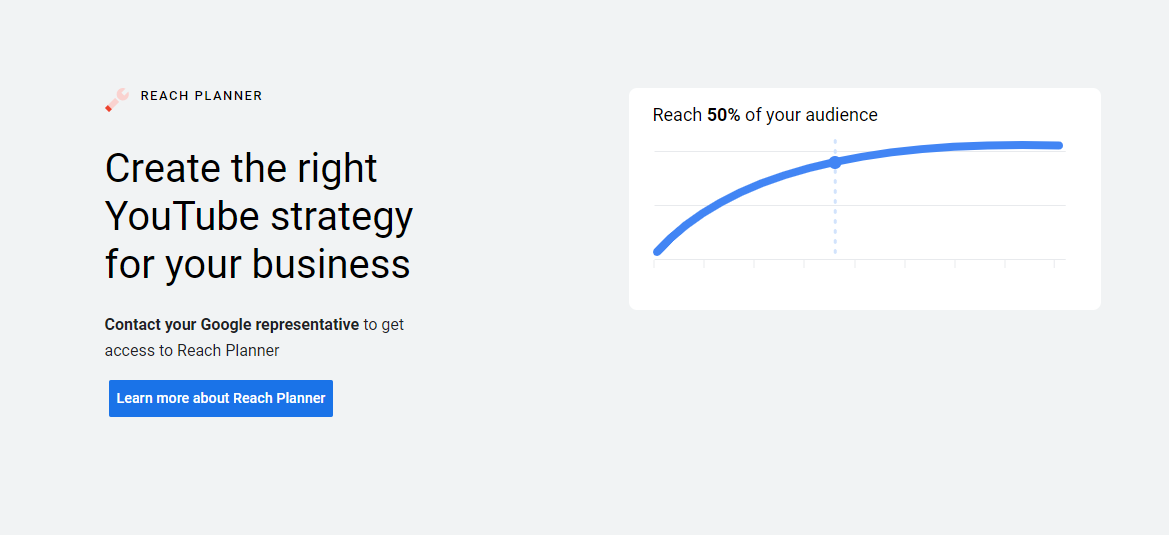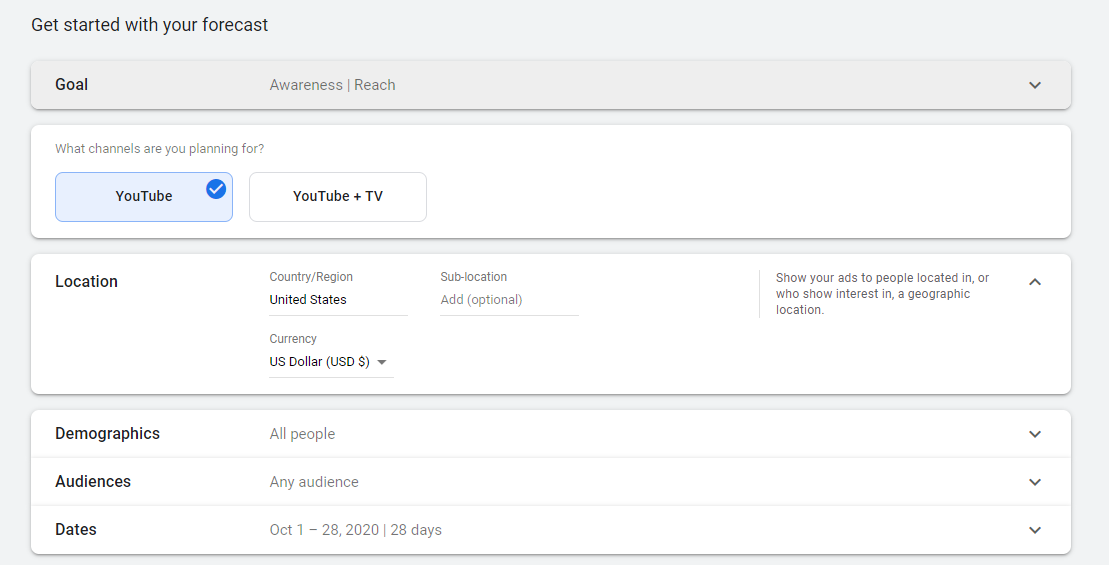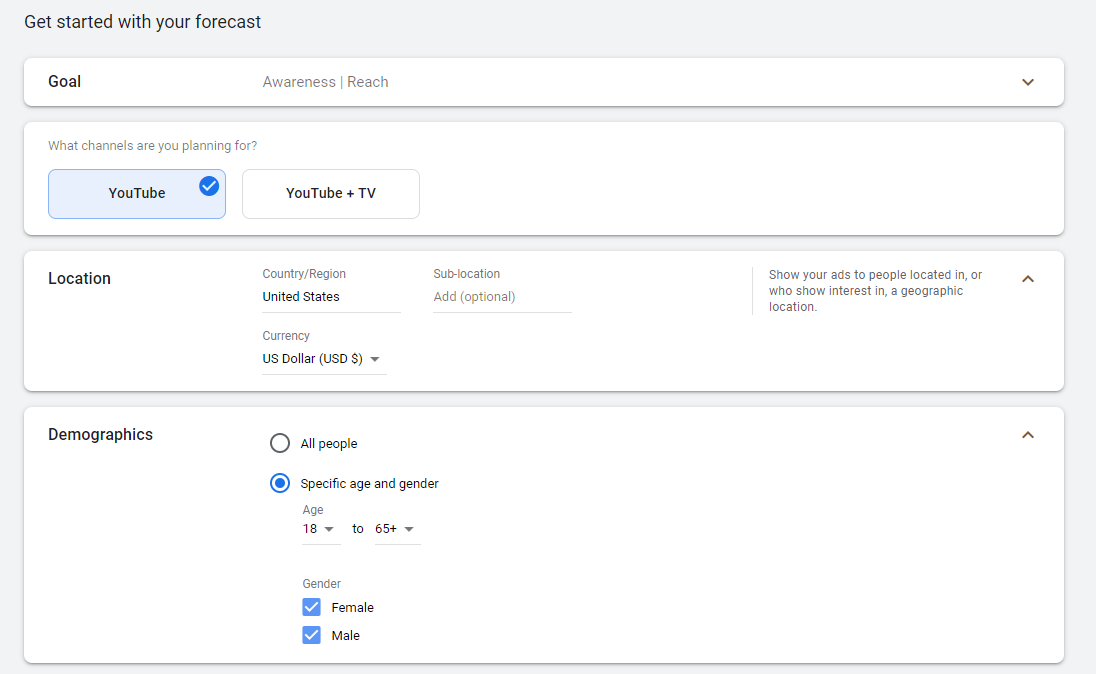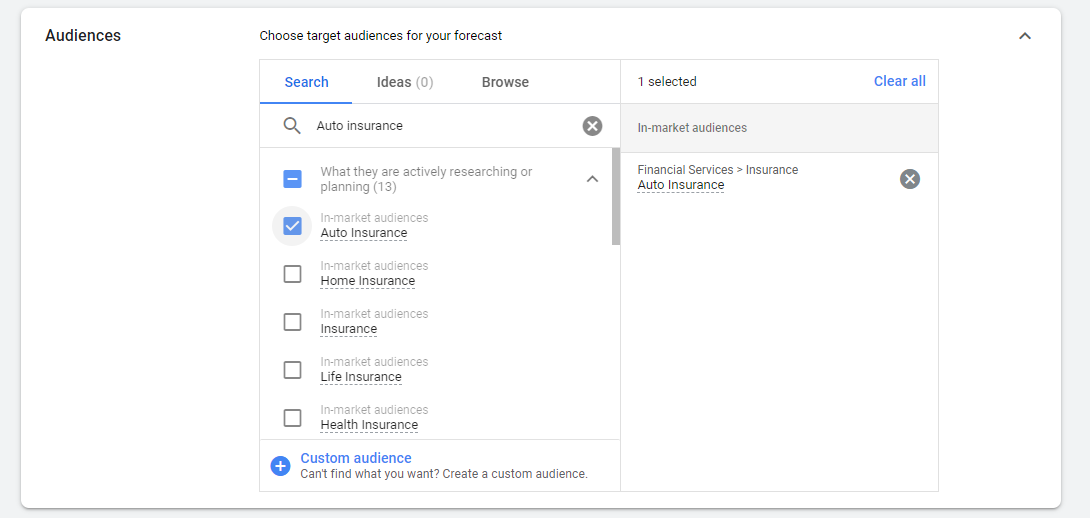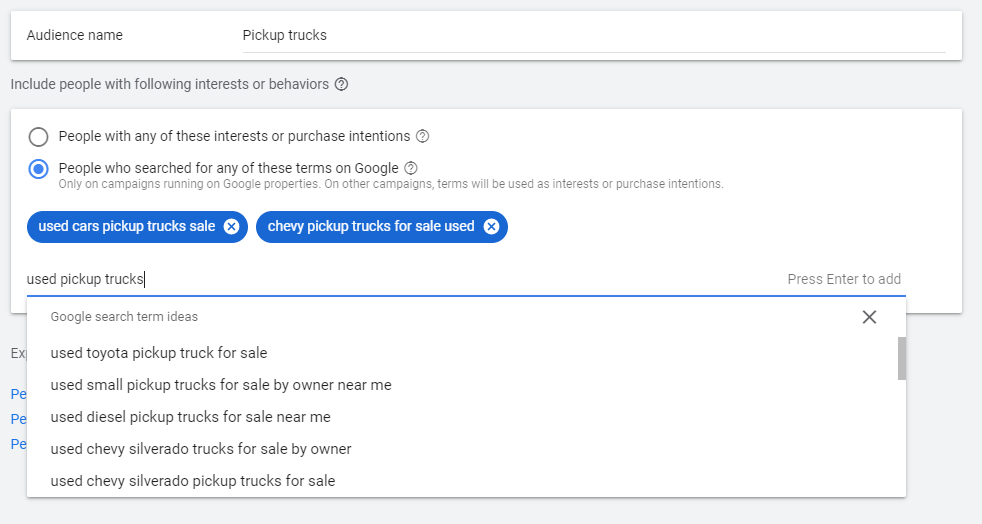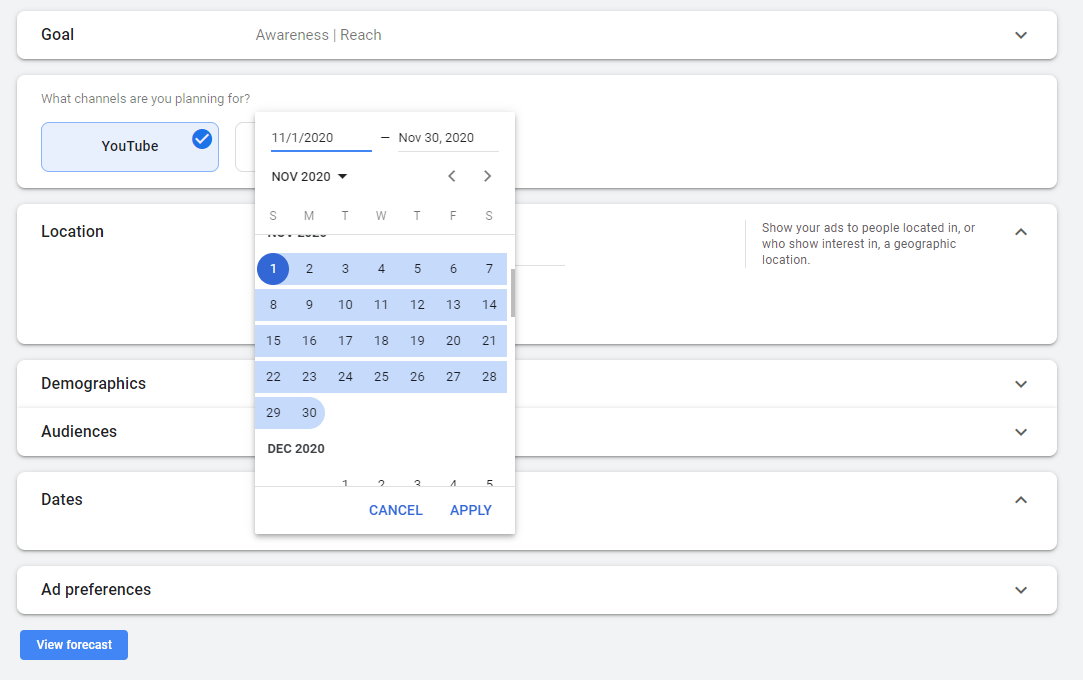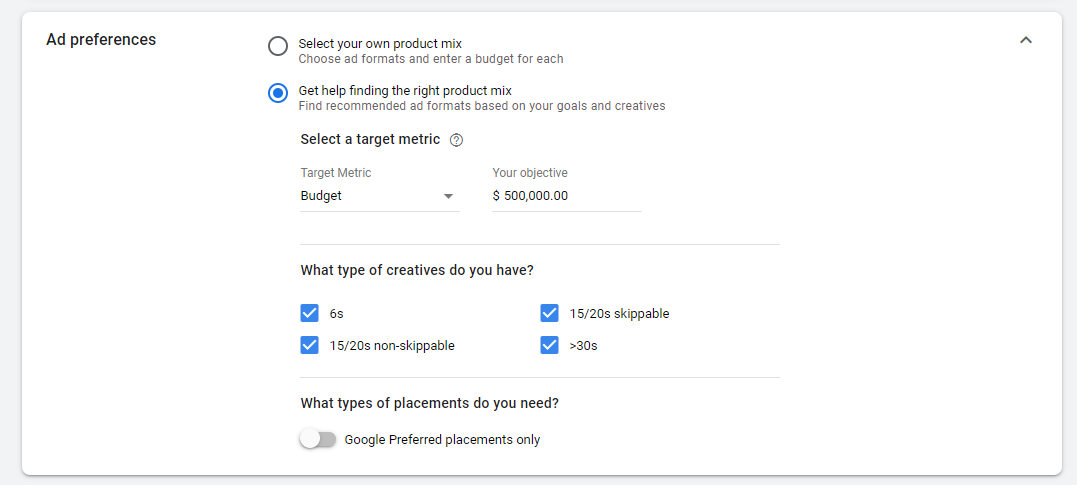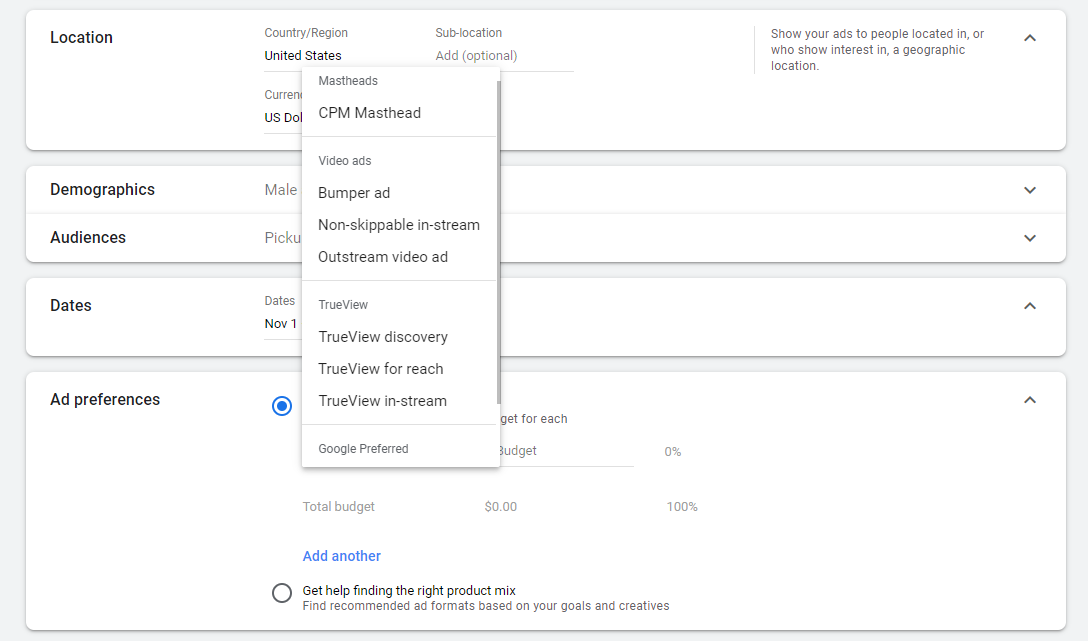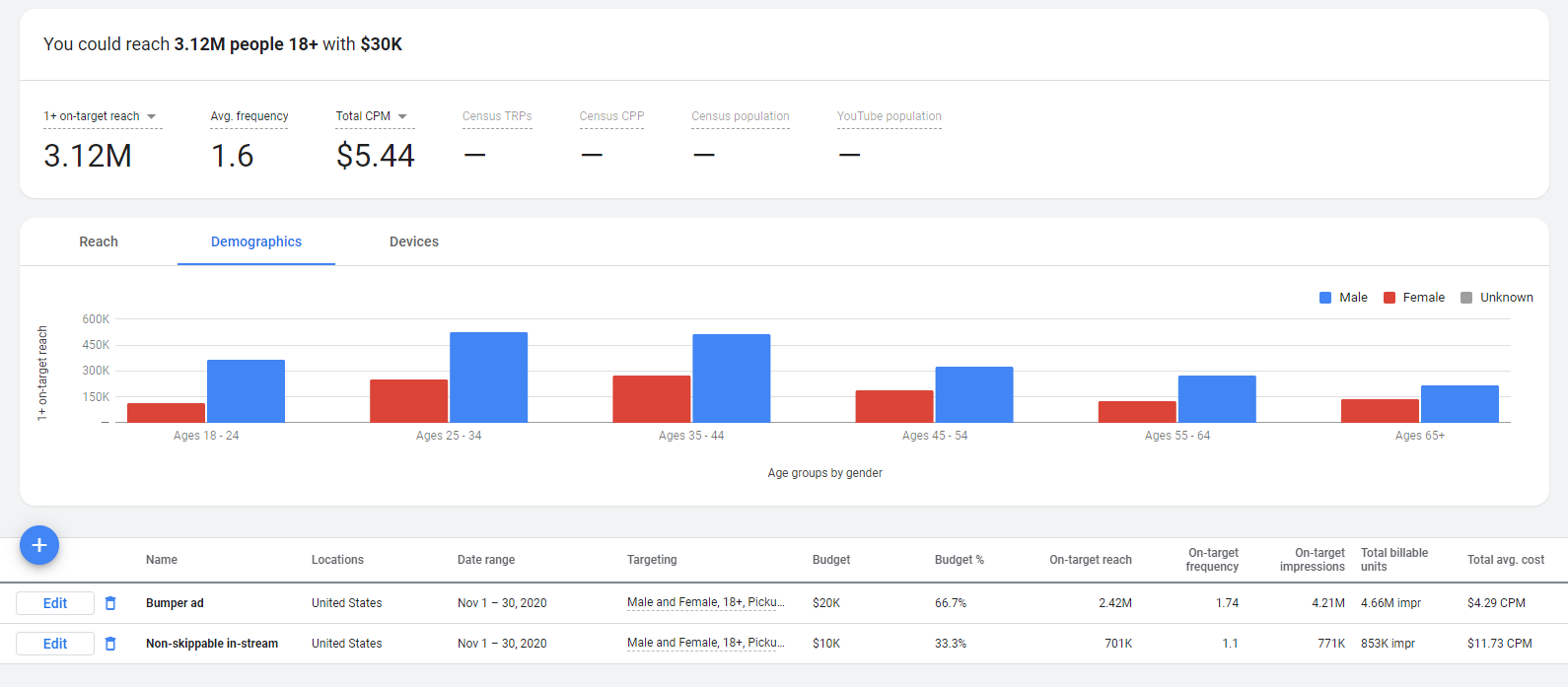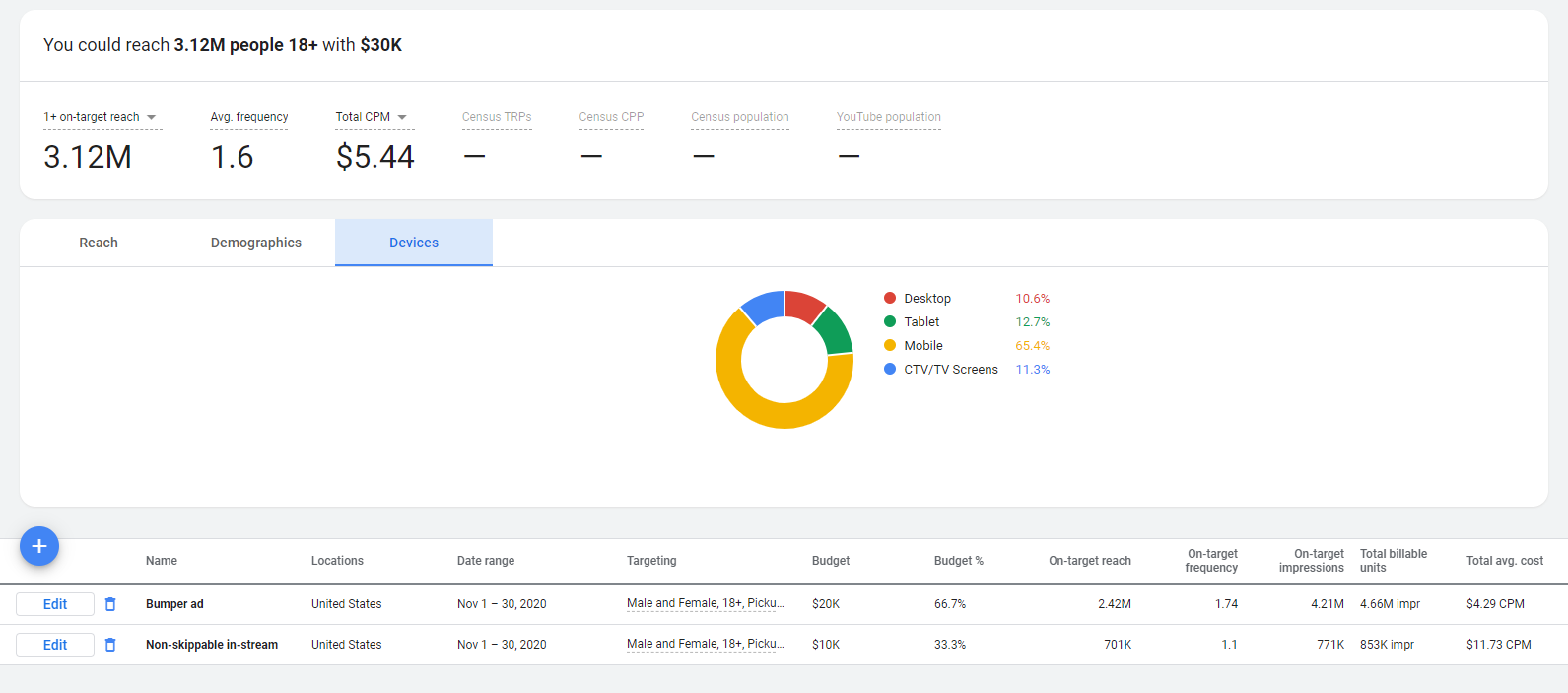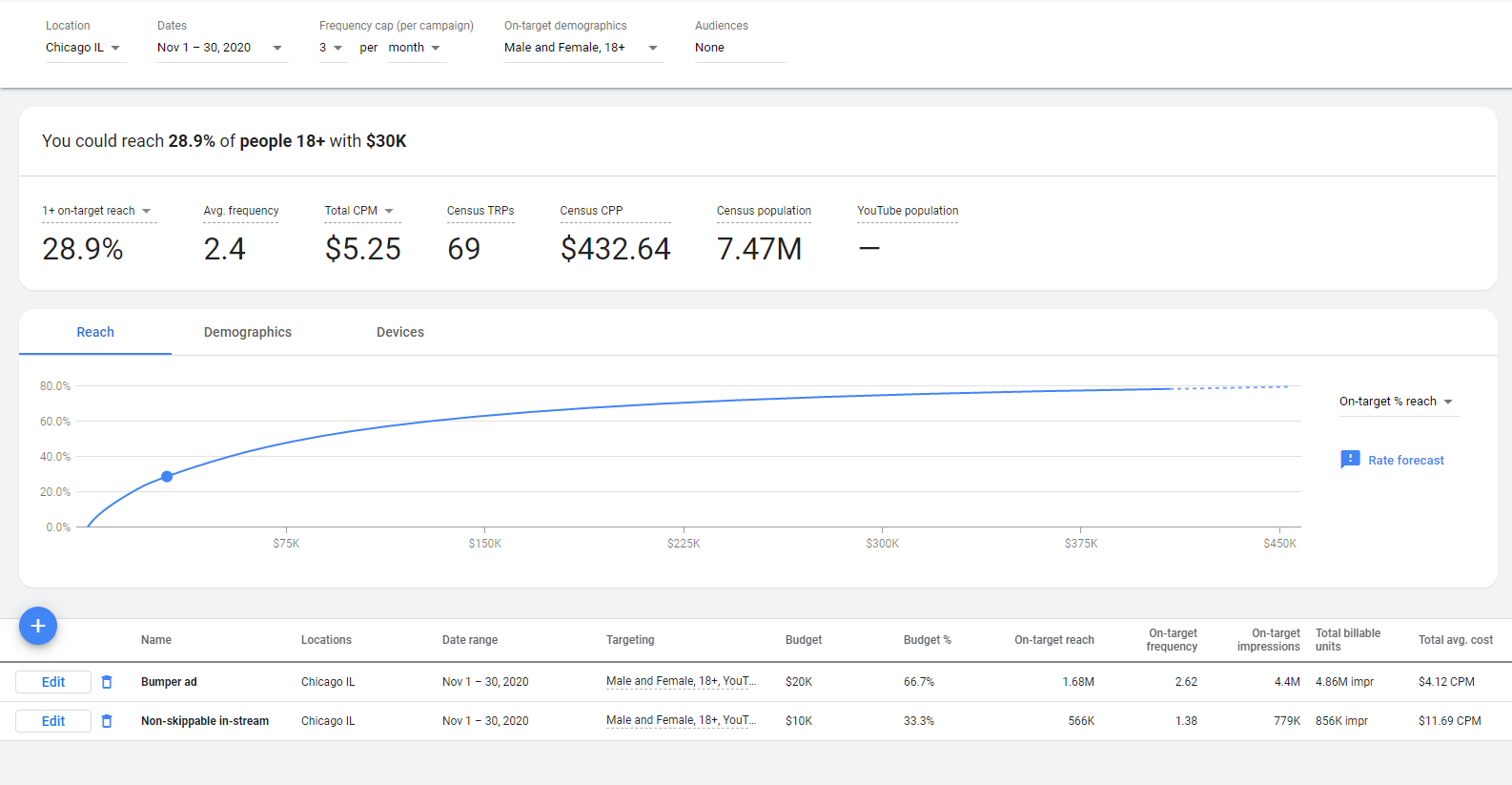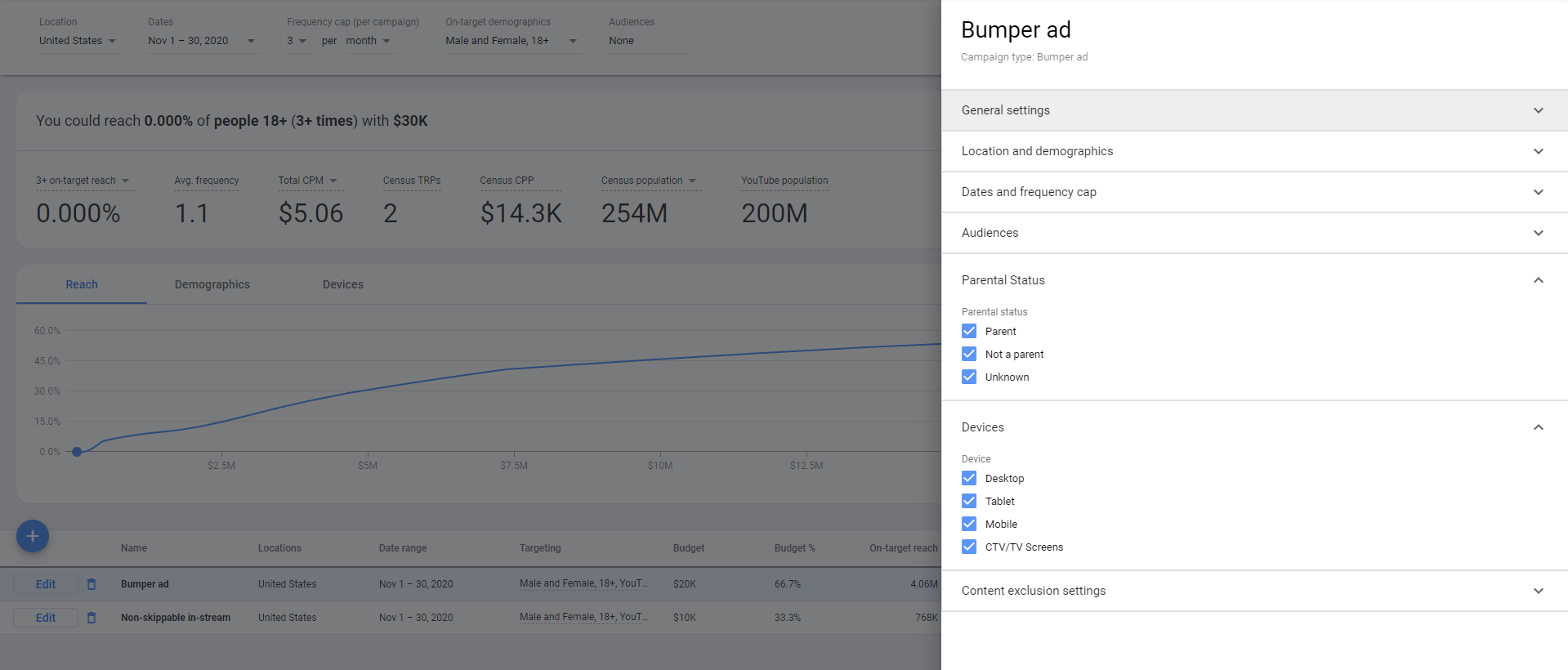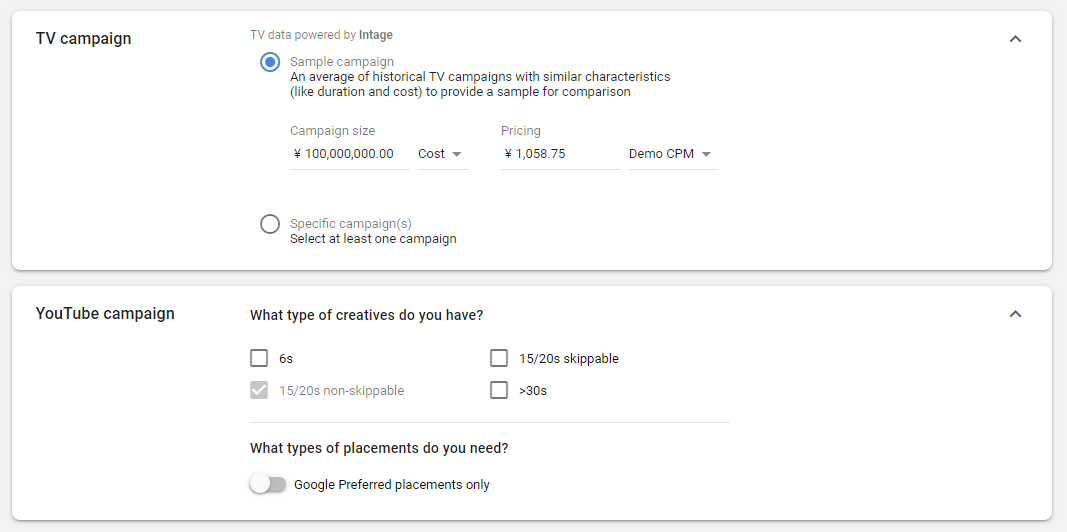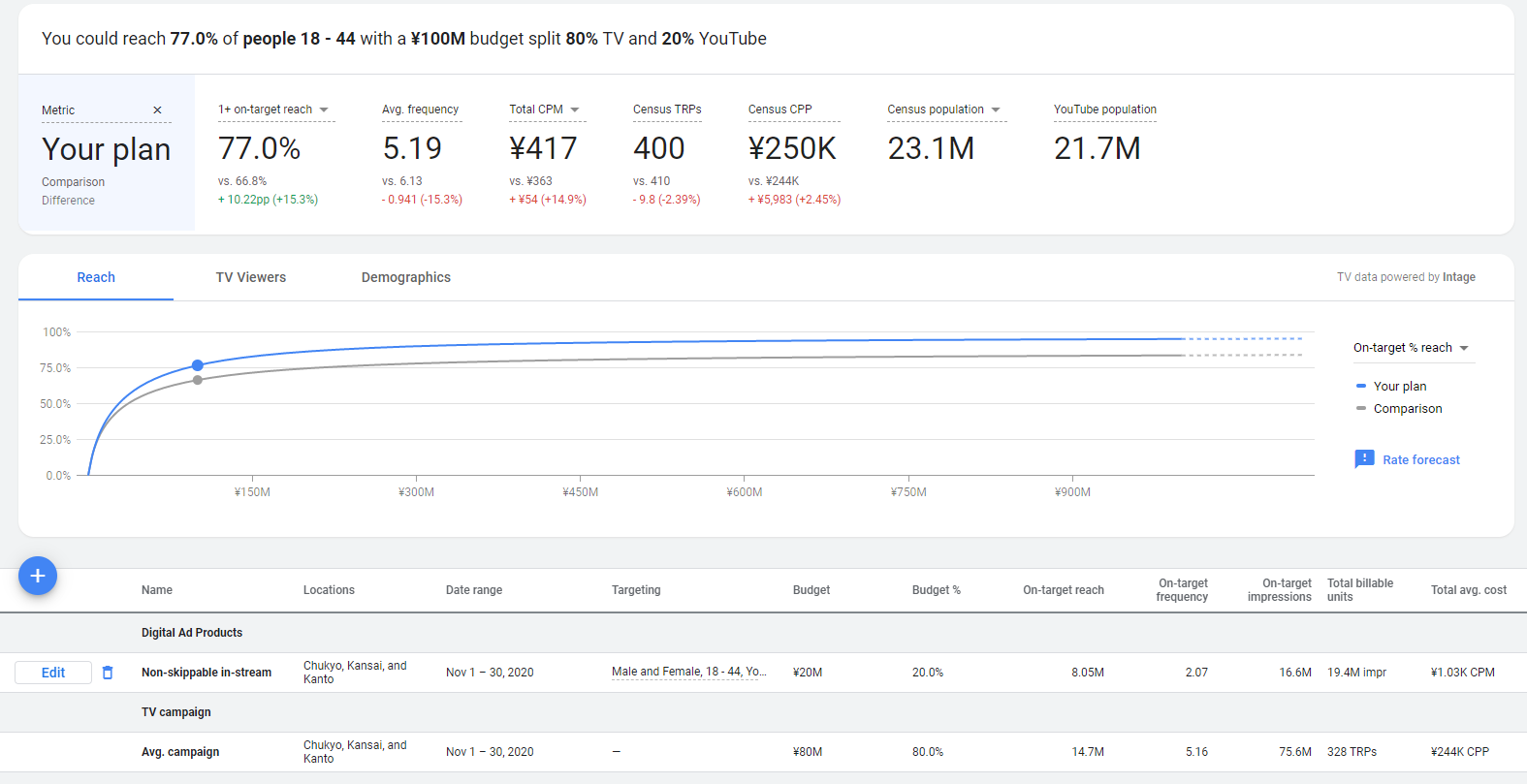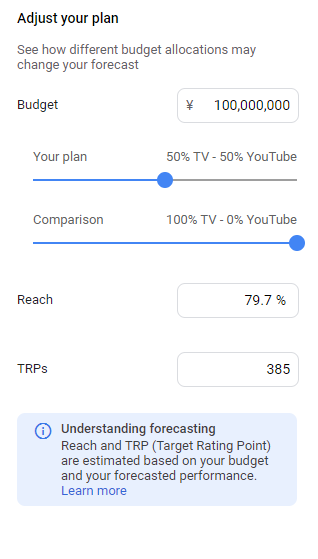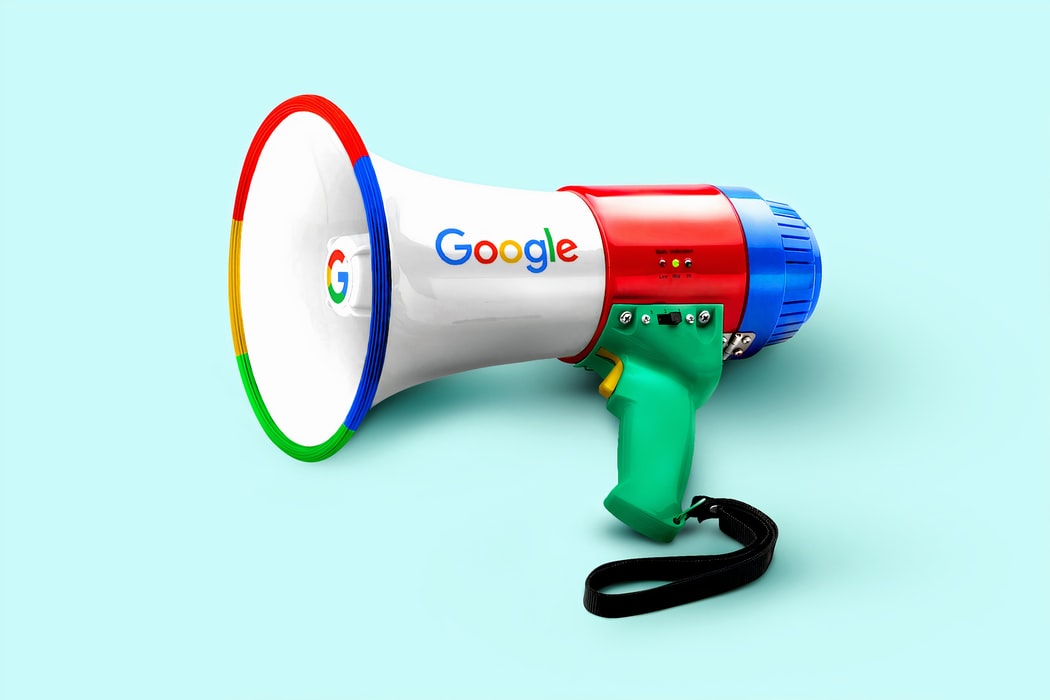
One of the most exciting features in Google Ads is a tool called Google Reach Planner.
Google Reach Planner is a powerful tool that allows brands and agencies to estimate the potential reach of their YouTube campaigns under various scenarios and conditions.
You can easily select demographic, interest and behavioral targeting options.
If your brand requires a niche audience you can even target consumers based on topics that they have searched for on Google.
You can adjust your budget, campaign frequency, geographic location, video length and much more.
Perhaps, your campaign needs a mix of different video lengths, but you want your bumper ads to run for fewer days than your non-skippable 15 second video.
Well, that is very easy to do in Google Reach Planner.
There are almost endless variations that you can test
What makes Google Reach Planner even more exciting is that it is continuously being improved.
In 2020 Google added the option to estimate cross-media reach for TV and YouTube.
Currently, this option is only available for Vietnam and Japan (Chukyo, Kansai and Kanto; separately for Kansai and Kanto).
As Google adds new TV markets, brands and agencies will have another valuable data point, which will help them in making the right decision regarding budget allocation across TV and digital.
In order to fully demonstrate the capabilities of Google Reach Planner, we have created this article.
Starting up Google Reach Planner
You can access the feature by clicking on the Tools icon in the upper menu in your Google Ads account.
When the menu becomes available, direct your view to the Planning section.
Under this section you usually see things like Performance Planner, Keyword Planner and Ad preview and Diagnostics.
Sandwiched between one of these items should be the Google Reach Planner link.
Sadly, not every advertiser has access to the tool. If you see the screen below, you have to reach out to your Google representative.
Creating a basic scenario in Google Reach Planner
Your first major choice is between a pure-play YouTube campaign and YouTube+TV.
For the purposes of this deep-dive, let us go with just YouTube.
We’ll come back to this step again later in this article.
Once you have selected YouTube, your second choice is to pick a location or a sub-location.
For example, you can select United States but then narrow it down to a specific market such as a state or a city.
Then, you should decide your basic demographic targeting. You can select gender and pick between several age brackets:
- 18-24
- 25-34
- 35-44
- 45-54
- 55-64
- 65+
If you have a campaign that requires a more targeted approach, you can customize your audience.
The fastest way is to use the search or browse functions to see what Google has available for you.
However, you can also go even further with the “Custom audience” feature.
With the “Custom Audience” option you can pick between these two options:
- People with any of these interests or purchase intentions – Enter keywords describing your ideal customer’s interests or products and services they are actively researching to buy. Your ads will reach people with those interests or purchase intentions based on your campaign settings, such as marketing objective or bidding strategy.
- People who searched for any of these terms on Google – Enter search terms your ideal customer is using on Google. Your ads will reach people who search for those and similar terms only on campaigns running on Google properties. On other campaigns, the terms will be used as interests or purchase intentions.
Another important decision is picking the timeframe of your campaign.
Among other factors, your campaign will also be affected by the price seasonality of your market.
For most markets, there are periods where there is more competition, which drives up costs.
This includes things like Black Friday and the Christmas shopping season.
Let us say that you have several videos of varying lengths. You know your campaign budget, but you are not sure how to allocate this budget among your video assets.
In this case, simply choose the “Get help finding the right product mix” option, input your budget and select the types of creatives that match the four available options:
- 6s (bumper ad)
- 15/20s skippable
- 15/20s non-skippable
- >30s (skippable)
For bigger markets you also have the option to select your ads to only appear in Google Preferred placements. Google Preferred, or YouTube Select as it is now called, gives advertisers the chance to place their ads in content that is selected and curated by YouTube themselves.
Only a select group of YouTube creators are part of this program. Names like Will Smith, Emma Chamberlain, MrBeast, Marques Brownlee, Markiplier, Liza Koshy and other major YouTubers are all part of YouTube Select.
The content creators who are part of YouTube Select create original, high-quality content that is safe for brands.
If you decide that you would rather have more control over the budget allocation across your video ads, you can pick the “Select your own product mix” option.
This choice will give you the option to input budgets for individual video formats.
You have the following list of options:
- Mastheads
- CPM Masthead
- Video ads
- Bumper ad
- Non-skippable in-stream
- Outstream video ad
- TrueView
- TrueView discovery
- TrueView for reach
- TrueView for in-stream
- Google Preferred
- 15 or 20 sec. video ad
- Bumper ad
This list will depend on which market you are targeting. For example, the list is more limited for smaller markets.
Evaluating your results
Once you have created your basic scenario Google Reach Planner will generate a forecast.
In the example below, we allocated $20,000 for Bumper ads and $10,000 for 15/20 sec. non-skippable ads.
We also created a custom audience of consumers who are interested in “used pick-up trucks for sale” and “used chevy pickup trucks for sale”.
Based on these conditions, YouTube estimates that with a combined budget of $30,000 we will be able to reach 3.12 million consumers ages 18+ in the span of one month.
The CPM for non-skippable in-stream ads will be $11.73 and the CPM for your standard bumper ads is forecasted at $4.29.
In this case, Google estimates that your total campaign CPM will be $5.44.
Keep in mind, though, that your results may be different and Google does not guarantee these figures.
Furthermore, if you select the Demographics tab, you will see the number of men and women that will see your ads across different age brackets. Since we are looking for consumers who want to buy a used pickup truck, it is no surprise that this campaign will reach more men than women.
In addition, Google Reach Planner will also display where your target audience will most likely view your ads.
Based on our decisions in building this scenario, 65.5% of our potential audience will see our videos on mobile devices.
If you want to adjust your scenario, you can do so easily. Nearly everything can be changed from the forecast interface window.
Creating a broader campaign in Google Reach Planner
If you look closely at the screens in the previous examples, you notice that Census TRPs, Census CPP, Census population and YouTube population are all empty.
The reason why these metrics are empty is because we used a custom audience in our previous examples.
However, if we target a broader audience we can see and evaluate the potential reach of our campaign in more ways.
With the same targeting setup as in the previous scenario, let us remove the custom audience.
In other words, let us see how many consumers ages 18 and over in the US we can reach with just $30,000.
The answer is not many.
Google Reach Planner forecasts that we can achieve just 1.91% on-target reach, which is equivalent to just 2 TRPs.
Under this campaign setup, you can see the estimated Census population and YouTube population.
According to Google there are 254 million consumers 18+ in the US and an impressive 78% of them are on YouTube.
However, remember that you can also select sub-locations such as a specific state or city?
If your business is based in Chicago, Illinois, your $30,000 will go a long way if you only select your geographic market.
In this example, you will be able to reach 28.9% of all consumers ages 18 and over who live in Chicago.
Making advanced changes to your Google Reach Planner campaign
When you have several video assets in your campaign, you can adjust each one individually. If you click on the Edit button, you can change the following settings:
- General settings
- Location and demographics
- Dates and frequency cap
- Audiences
- Parental status
- Devices
- Content exclusion settings
In other words, you could create a scenario where one of your ads targets a custom audience and the other one aims to reach your broad targeting.
Creating a broader campaign in Google Reach Planner
Without a doubt, the most exciting feature in Google Reach Planner is the YouTube+TV model.
Although it is only available in Vietnam and Japan, the insights and learnings can be transferred to other markets.
Let us target men and women in the 18-44 age bracket. Our campaign will run in November 2020 and we will target the Chukyo, Kansai and Kanto regions.
To make things easier for comparison, select only 15/20 sec. non-skippable ads.
We will invest ¥100,000,000 (approximately $952,898) across TV and YouTube and let Google Reach Planner decide how to split the budget.
By default Google Reach Planner will create an 80:20 split in favor of TV.
This budget allocation will result in 77% 1+ on-target reach and generate 400 TRPs.
If you look at the details on the bottom of the page, you can see that the TV campaign will reach 14.7 million consumers whereas the YouTube campaign will be viewed by 8.05 million.
And here comes the most interesting part of this deep-dive.
Google Reach Planner allows brands and agencies to see their potential campaign reach if they adjust the budget split between TV and YouTube.
Under the 80:20 split in favor of TV, the campaign reach was estimated at 77%.
However, when we adjust it to 50:50 we can increase our on-target reach by 2.7 percentage points to 79.7%.
Conclusion
Google Reach Planner is a powerful tool. It provides advertisers and agencies with another data point in their planning decisions.
We sincerely hope that Google continues to improve this tool by adding new functionality and new TV markets.
If you are starting out with YouTube advertising or with Google Ads, in general, feel free to read more about our services.
Feature photo by Morning Brew on Unsplash


